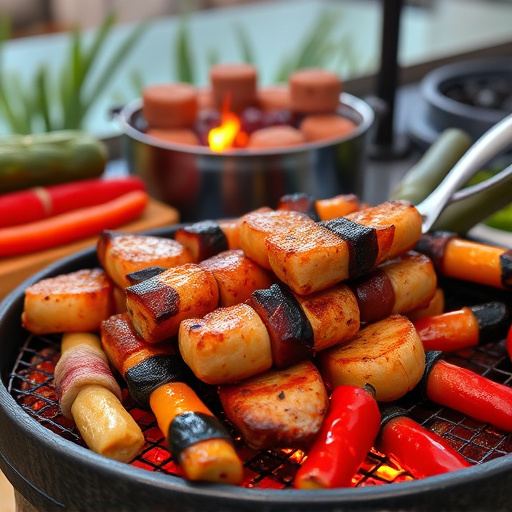To achieve a perfect Smoked BBQ Brisket Recipe, select a whole packer brisket with good marbling for even cooking and juiciness. Apply a generous dry rub of garlic, paprika, salt, pepper, and brown sugar at least an hour before cooking. Master the art of smoking brisket using indirect heat and hardwoods like oak or hickory at 225-250°F (107-121°C) for up to 1.5 hours per pound. Rest wrapped in butcher paper after slow cooking for tender, juicy results. Pair with creamy sides, coleslaw, grilled corn, and bold red wines or craft beers.
“Unleash your inner BBQ master with the ultimate guide to crafting the perfect smoked BBQ brisket. From selecting the ideal cut to mastering slow-cooking techniques, this comprehensive journey delves into every detail of achieving tender, smoky perfection. Learn the art of dry rub seasoning and discover secrets to achieving a deep, enticing aroma that will have folks lining up for seconds. Whether you’re an experienced pitmaster or a novice chef, this guide provides all the essential tips and tricks for creating a mouthwatering smoked brisket recipe.”
- Selecting the Perfect Brisket Cut
- Dry Rub Seasoning for Maximum Flavor
- Mastering the Smoking Process
- Achieving a Deep, Smoky Aroma
- Slow Cooking Techniques for Tender Meat
- Serving Suggestions and Pairings
Selecting the Perfect Brisket Cut
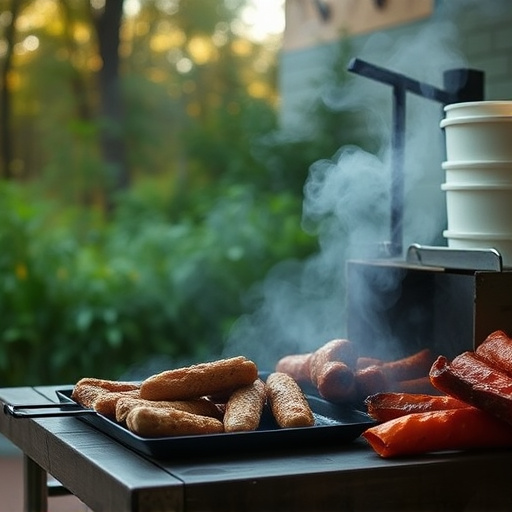
When it comes to achieving that perfect smoky aroma in your smoked BBQ brisket recipe, selecting the right cut is half the battle won. Look for a whole packer brisket with good marbling; this fat cap not only adds flavor but also helps keep the meat moist during the slow-cooking process. Aim for a cut with both the point and flat muscles intact—this balance ensures even cooking. Avoid cuts that are heavily trimmed, as they may dry out more quickly. The ideal brisket should have a thick layer of fat, which will render down into delicious juices, enhancing every bite of your mouthwatering smoked BBQ brisket recipe.
For best results, consider buying a brisket with a 1.5-inch or thicker fat cap. This ensures there’s enough fat to keep the meat juicy and flavorful as it smokes for several hours. Remember, the right cut is a crucial step in crafting that tender, smoky masterpiece—a true delight for any barbecue enthusiast.
Dry Rub Seasoning for Maximum Flavor
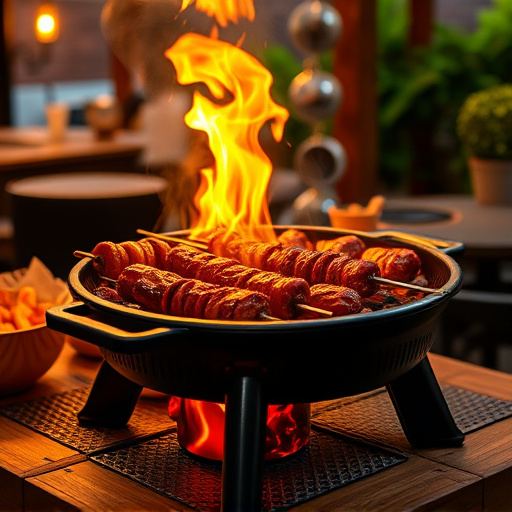
To achieve a truly exceptional smoked BBQ brisket, dry rub seasoning plays a pivotal role in enhancing its flavor profile. This simple yet potent mix of spices acts as a protective crust on your meat, locking in juices and intensifying its natural tastes. A well-balanced dry rub for brisket should include a blend of garlic, paprika, salt, pepper, and brown sugar – a combination that creates a deep, smoky aroma coveted by BBQ enthusiasts.
Applying the seasoning correctly is key. For maximum penetration, rub the brisket generously with the spice mixture at least an hour before cooking, massaging it into the meat to ensure even distribution. This step allows the spices to infuse and deepen the overall taste of your smoked BBQ brisket recipe.
Mastering the Smoking Process
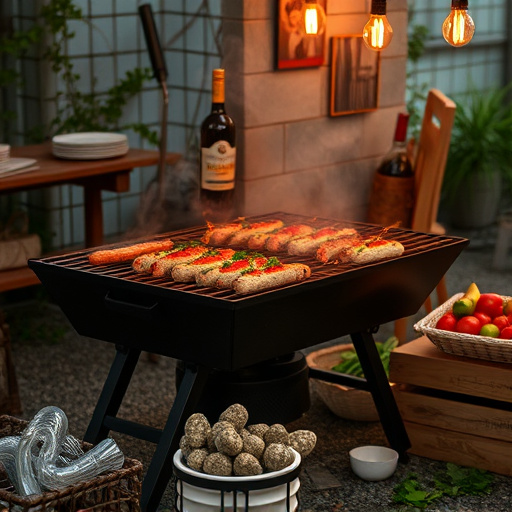
Mastering the smoking process is an art that every aspiring smoked BBQ brisket chef must embrace. The key to achieving a tender, juicy brisket with a deep, smoky aroma lies in understanding the science behind it. Smoking involves slowly cooking meat at low temperatures, usually between 107°F and 225°F (42°C to 113°C), using indirect heat and smoke from wood chips or chunks. This method allows for a gradual transformation of the brisket’s texture and flavor.
Choosing the right wood is crucial; mesquite, oak, hickory, and cherry are popular options, each imparting unique flavors. Maintaining a consistent temperature is essential; fluctuations can affect the meat’s moisture content and cooking time. Patience is also key; brisket takes time to cook, often 1-1.5 hours per pound, ensuring it reaches an internal temperature of around 203°F (95°C) for maximum tenderness. This meticulous approach will result in a smoked BBQ brisket recipe that’s sure to impress, with a perfect balance of smoky flavor and melt-in-your-mouth texture.
Achieving a Deep, Smoky Aroma
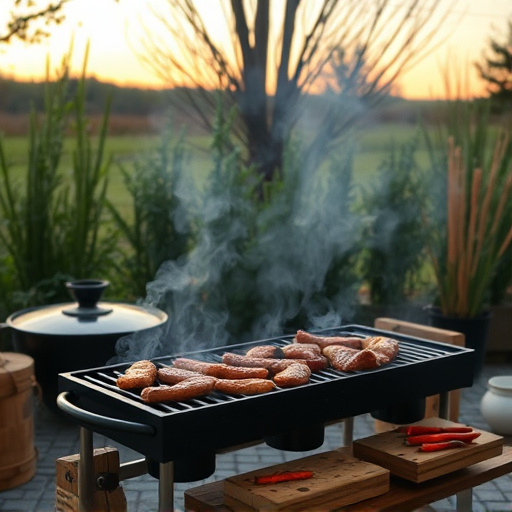
To achieve a deep, smoky aroma in your smoked BBQ brisket recipe, the key lies in the smoking process. Start by selecting a quality brisket with good marbling—this fat will render during cooking, adding flavor and moisture. Preheat your smoker to the ideal temperature range of 225-250°F (107-121°C). This slow cooking allows for extensive smoke absorption. Use hardwoods like oak, hickory, or mesquite for a rich, distinct smoky flavor. Maintain consistent low heat and regularly add smoked wood chips to keep the aroma going strong.
Rubbing the brisket with a dry rub before smoking is another essential step. A blend of spices such as salt, pepper, garlic powder, and paprika will enhance its natural flavors. After about 1-1.5 hours per pound at low heat, wrap the brisket in butcher paper to retain moisture and let it rest for a couple of hours. This resting period allows the juices to redistribute, ensuring tender, smoky goodness.
Slow Cooking Techniques for Tender Meat
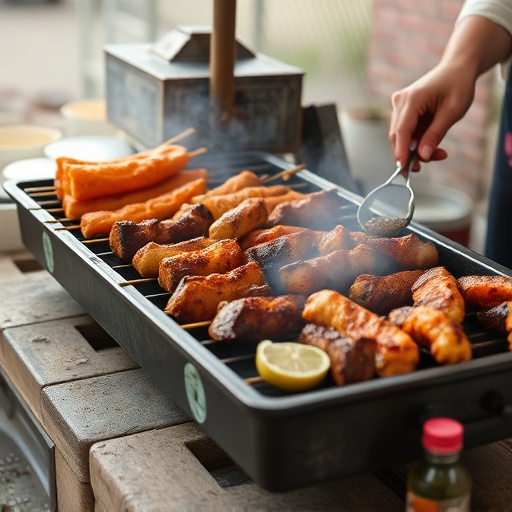
Slow cooking is a technique that transforms tough cuts of meat, like brisket, into melt-in-your-mouth tenderness. When it comes to achieving that perfect smoky aroma for your Smoked BBQ Brisket Recipe, time and low temperature are your allies. The slow and steady process allows the collagen in the meat to break down, resulting in a tender texture.
This method involves using a crockpot or a Dutch oven at low to medium-low heat for several hours—or even days—to cook the brisket. By keeping the heat low, you maintain a consistent cooking temperature, ensuring even distribution of moisture and flavor. The slow cooking technique not only makes the brisket tender but also infuses it with the rich, smoky tastes associated with BBQ brisket recipes.
Serving Suggestions and Pairings
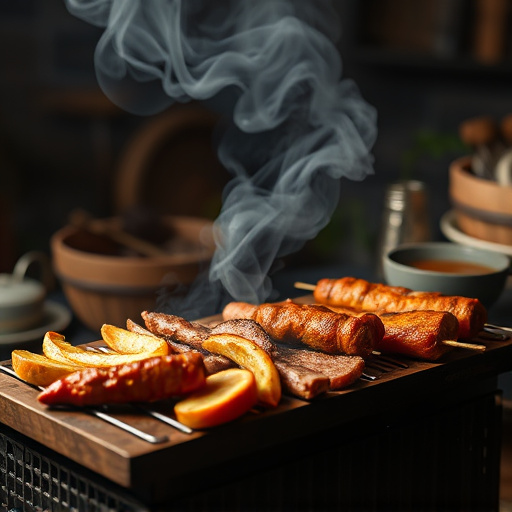
When serving this tender brisket with a deep smoky aroma, known as a smoked BBQ brisket recipe, there are several options to consider for an optimal dining experience. A classic pairing is to serve it on a bed of creamy mashed potatoes, allowing the rich flavors to complement each other. Accompanying sides like coleslaw and grilled corn on the cob add texture and freshness, balancing the intense smokiness of the brisket.
For a complete meal, consider a glass of robust red wine, such as a Zinfandel or Cabernet Sauvignon, which can stand up to the bold BBQ flavors. Alternatively, craft beers, especially those with a touch of smoke or chili, can also enhance the dining experience. Don’t forget about traditional condiments like barbecue sauce and a drizzle of garlic-herb butter for an extra layer of deliciousness.
